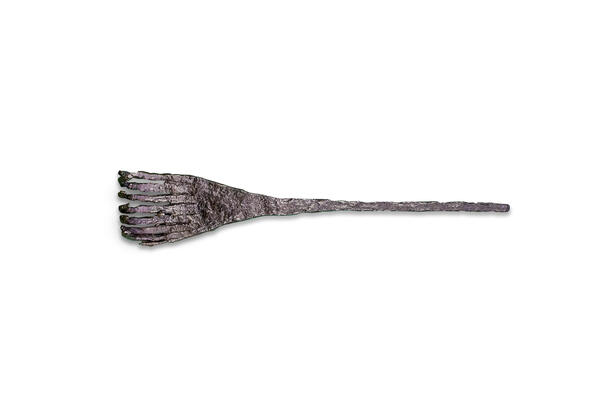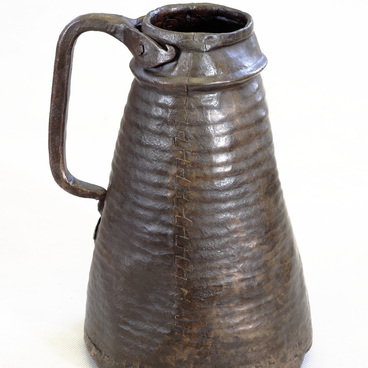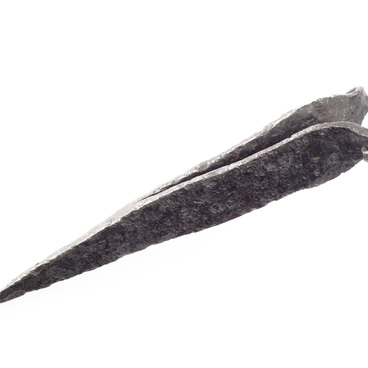Medieval Volga Bulgaria was a country with a developed economy at that time. The economy was based on agriculture, handicraft production, domestic and foreign trade. The villagers were engaged in agriculture and cattle breeding. The secretary of the embassy of the Abbasid Caliphate, Ahmad ibn Fadlan, wrote in his notes,
Horse scraper
Creation period
the 10th-14th century
Dimensions
21,5x4 cm
Technique
iron, hammering
0
Open in app#1
Horse scraper
#2
#4
Their food (of Bolgars) is millet and horse meat, but they also have a lot of wheat and barley.
#5
Cattle breeding was an important branch of agriculture. It provided people with meat and dairy products. Wool was used for making felt and fabric. Leather and bone-cutting crafts were also based on raw materials supplied by cattle breeding.
Volga Bolgars bred cows, bulls, horses, sheep, and goats. These were large animals that differed favorably from both Finnish and those kept in Russian principalities. Horses were used as daily transport, oxen — as animal traction during plowing.
The feudal lords bred special types of horses for military affairs, hunting, and entertainment. Various devices were purchased to take care of horses. They were combs and scrapers. The collection of Bolgar Museum-Reserve contains a scraper to comb horses. It could also be used for combing fighting camels and animals from trade caravans. The scrapers were made by Bolgar blacksmiths.
Ferrous metallurgy and metalworking were the leading industries in Volga Bulgaria. The metallurgical district of Bilyar occupied a huge area at that time — more than one hectare. The products of Bulgar blacksmiths and foundry workers were sold not only at the domestic market, but were also exported to other countries.
Kilns were used to obtain metal from ore. These are hemispherical furnaces made of raw bricks. This device was equipped with air ducts, which supplied the air into the kiln through bellows. Finely ground iron ore and charcoal were loaded into the kilns. The coal was burned, the ore melted and molten iron flowed to the kiln bottom plate. This alloy was sent to blacksmith workshops.
Volga Bolgars bred cows, bulls, horses, sheep, and goats. These were large animals that differed favorably from both Finnish and those kept in Russian principalities. Horses were used as daily transport, oxen — as animal traction during plowing.
The feudal lords bred special types of horses for military affairs, hunting, and entertainment. Various devices were purchased to take care of horses. They were combs and scrapers. The collection of Bolgar Museum-Reserve contains a scraper to comb horses. It could also be used for combing fighting camels and animals from trade caravans. The scrapers were made by Bolgar blacksmiths.
Ferrous metallurgy and metalworking were the leading industries in Volga Bulgaria. The metallurgical district of Bilyar occupied a huge area at that time — more than one hectare. The products of Bulgar blacksmiths and foundry workers were sold not only at the domestic market, but were also exported to other countries.
Kilns were used to obtain metal from ore. These are hemispherical furnaces made of raw bricks. This device was equipped with air ducts, which supplied the air into the kiln through bellows. Finely ground iron ore and charcoal were loaded into the kilns. The coal was burned, the ore melted and molten iron flowed to the kiln bottom plate. This alloy was sent to blacksmith workshops.
Bolgar blacksmiths used various tools for metalwork: hitting tools, hammers, anvils, chisels, files, tongs. There were specializations in blacksmithing. In some workshops, agricultural tools were produced, in others, gunsmiths worked; some shops were used for making knives, scissors, locks, keys, and other things necessary in everyday life.
#3
Ministry of Culture of the Russian Federation
read morehide
00:00
00:00
1x
Horse scraper
Creation period
the 10th-14th century
Dimensions
21,5x4 cm
Technique
iron, hammering
0
Open in app
Share



